
Zaxxon is an isometric shooter arcade video game, developed and released by Sega in 1982. The player pilots a ship through heavily defended space fortresses. Japanese electronics company Ikegami Tsushinki also developed the game.
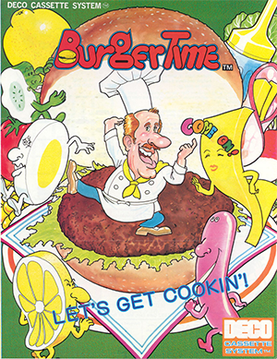
BurgerTime, originally released as Hamburger in Japan, is a 1982 arcade video game developed by Data East, initially for its DECO Cassette System. The player is chef Peter Pepper, who must walk over hamburger ingredients in a maze of platforms and ladders while avoiding anthropomorphic hot dogs, fried eggs, and pickles which are in pursuit.

Frogger is a 1981 arcade action game developed by Konami and manufactured by Sega. In North America, it was released by Sega/Gremlin. The object of the game is to direct five frogs to their homes by dodging traffic on a busy road, then crossing a river by jumping on floating logs and alligators.
1983 has seen many sequels and prequels in video games, such as Mario Bros. and Pole Position II, along with new titles such as Astron Belt, Champion Baseball, Dragon's Lair, Elevator Action, Spy Hunter and Track & Field. Major events include the video game crash of 1983 in North America, and the third generation of video game consoles beginning with the launch of Nintendo's Family Computer (Famicom) and Sega's SG-1000 in Japan. The year's highest-grossing video game was Namco's arcade game Pole Position, while the year's best-selling home system was Nintendo's Game & Watch for the third time since 1980.
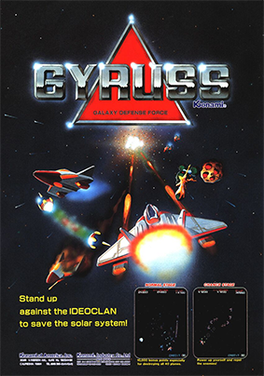
Gyruss is shoot 'em up arcade video game designed by Yoshiki Okamoto and released by Konami in 1983. Gyruss was initially licensed to Centuri in the United States for dedicated machines, before Konami released their own self-distributed conversion kits for the game. Parker Brothers released contemporary ports for home systems. An enhanced version for the Family Computer Disk System was released in 1988, which was released to the North American Nintendo Entertainment System in early 1989.

Track & Field, also known as Hyper Olympic in Japan and Europe, is a 1983 Olympic-themed sports video game developed by Konami for arcades. The Japanese release sported an official license for the 1984 Summer Olympics. In Europe, the game was initially released under the Japanese title Hyper Olympic in 1983, before re-releasing under the US title Track & Field in early 1984.

Popeye is a 1982 platform game developed and released by Nintendo as an arcade video game. It is based on the comic strip of the same name created by E. C. Segar and licensed from King Features Syndicate. Some sources claim that Ikegami Tsushinki did programming work on the game. As Popeye, the player must collect hearts thrown by Olive Oyl from the top of the screen while being chased by Brutus. Popeye can punch bottles thrown at him, but can only hurt Brutus after eating the one can of spinach present in each level. Unlike Nintendo's earlier Donkey Kong games, there is no jump button. There are three screens.

Choplifter is a military themed scrolling shooter developed by Dan Gorlin for the Apple II and published by Broderbund in 1982. It was ported to the Atari 8-bit family the same year and also to the VIC-20, Commodore 64, Atari 5200, ColecoVision, MSX, and Thomson computers.
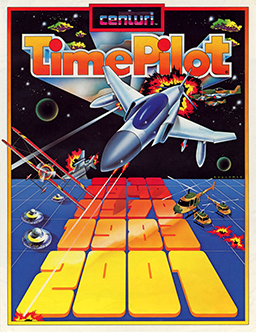
Time Pilot is a multidirectional shooter arcade video game designed by Yoshiki Okamoto and released by Konami in 1982. It was distributed in the United States by Centuri, and by Atari Ireland in Europe and the Middle East. While engaging in aerial combat, the player-controlled jet flies across open airspace that scrolls indefinitely in all directions. Each level is themed to a different time period. Home ports for the Atari 2600, MSX, and ColecoVision were released in 1983.
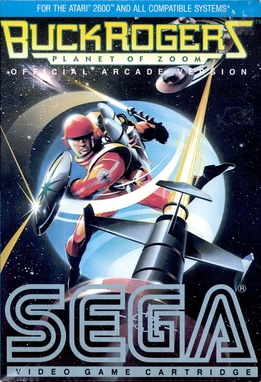
Buck Rogers: Planet of Zoom, known as Zoom 909 in Japan, is a pseudo-3D rail shooter released as an arcade video game by Sega in 1982. The player controls a spaceship in a third-person perspective, adapting the three-dimensional perspective of Sega's earlier racing game Turbo (1981) for the space shoot 'em up genre. It used the Buck Rogers license, referencing the space battles, though Buck himself is never seen.

Jungle King, re-released as Jungle Hunt, is a side-scrolling action game developed by Taito and released for arcades in 1982. It was originally distributed as Jungle King, then quickly modified and re-released as Jungle Hunt due to a copyright dispute over the player character's likeness to Tarzan. Jungle King, along with Moon Patrol released a month earlier, is one of the first video games with parallax scrolling.
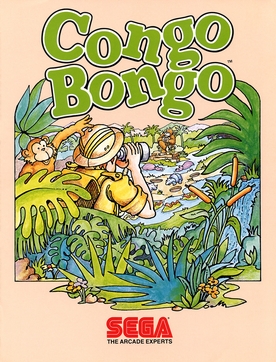
Congo Bongo, also known as Tip Top, is an platform game released as an arcade video game by Sega in 1983. A message in the ROM indicates it was coded at least in part by the company Ikegami Tsushinki. The game is viewed in an isometric perspective, like Sega's earlier Zaxxon (1982), but does not scroll. Numerous home ports followed.
1982 was the peak year for the golden age of arcade video games as well as the second generation of video game consoles. Many games were released that would spawn franchises, or at least sequels, including Dig Dug, Pole Position, Mr. Do!, Zaxxon, Q*bert, Time Pilot and Pitfall! The year's highest-grossing video game was Namco's arcade game Pac-Man, for the third year in a row, while the year's best-selling home system was the Atari 2600. Additional video game consoles added to a crowded market, notably the ColecoVision and Atari 5200. Troubles at Atari late in the year triggered the video game crash of 1983.

Mr. Do! is a 1982 maze game developed by Universal. It is the first arcade video game to be released as a conversion kit for other arcade machines; Taito published the conversion kit in Japan. The game was inspired by Namco's Dig Dug released earlier in 1982. Mr. Do! was a commercial success in Japan and North America, selling 30,000 arcade units in the US, and it was followed by several arcade sequels.

Super Cobra is a horizontally scrolling shooter developed by Konami, originally released as an arcade video game in 1981. It was published by Konami in Japan in March 1981 and manufactured and distributed by Stern in North America on June 22. It is the spiritual sequel to the Scramble arcade game released earlier in 1981. Super Cobra contains eleven distinct sections, versus six in Scramble, and is significantly more difficult, requiring maneuvering through tight spaces early in the game.
Centuri, formerly known as Allied Leisure, was an American arcade game manufacturer. They were based in Hialeah, Florida, and were one of the top six suppliers of coin-operated arcade video game machinery in the United States during the early 1980s. Centuri in its modern inception was formed when former Taito of America president Ed Miller and his partner Bill Olliges took over Allied Leisure, Inc. They renamed it "Centuri" in 1980.

SubRoc-3D is a first-person arcade shooter game released in 1982 by Sega. It is the second commercial video game in stereoscopic 3-D. It uses a periscope-shaped display with a different image for each eye. It was jointly developed by Sega and Matsushita Electric, who developed its active shutter 3D system. The game has stereo sound, and also changes the backdrop to reflect day, night, dawn, and dusk.

Tutankham is a 1982 arcade video game developed and released by Konami and released by Stern in North America. Named after the Egyptian pharaoh Tutankhamun, the game combines a maze shoot 'em up with light puzzle-solving elements. It debuted at the European ATE and IMA amusement shows in January 1982, before releasing worldwide in Summer 1982. The game was a critical and commercial success and was ported to home systems by Parker Brothers.
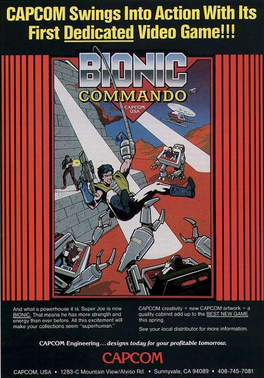
Bionic Commando, released in Japan as Top Secret is a run and gun platform game released by Capcom in arcades in 1987. It was designed by Tokuro Fujiwara as a successor to his earlier "wire action" platformer Roc'n Rope (1983), building on its grappling hook mechanic; he was also the designer of Commando (1985). The music was composed by Harumi Fujita for the Yamaha YM2151 sound chip.
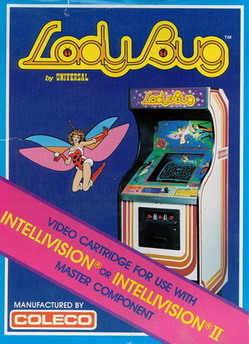
Lady Bug is a maze chase video game produced by Universal and released for arcades in 1981. Its gameplay is similar to Pac-Man, with the primary addition to the formula being gates that change the layout of the maze when used, adding an element of strategy to the genre. The arcade original was relatively obscure, but the game found wider recognition and success as a launch title for the ColecoVision console.
















